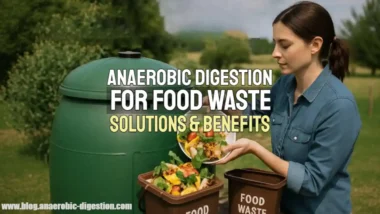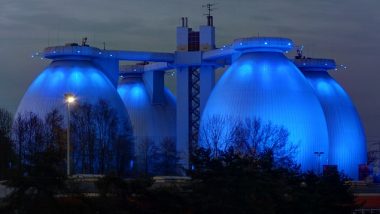We present our top Silage Clamp Tips because biogas plant silage storage is a vital, yet sometimes overlooked, part of successful anaerobic digestion. A well‑managed silage store gives AD plant operators a reliable feed source when other feedstocks are scarce and helps avoid damaging feedstock shocks to the digester.
This article is written for UK farmers, AD plant operators and consultants who manage or advise on silage storage. Read on for practical guidance on compliant clamp design, sealing with oxygen barrier films, compaction and safe feed‑out, plus a downloadable checklist to take to the site.
One thing every digester operator needs is the ability to feed the digester reliably throughout the year — and the key to that consistency is a well‑designed and maintained silage clamp. Success with silage can mean the difference between a profitable crop-waste-based biogas plant and an expensive liability.
Top 12 Silage Clamp Tips
Here is our top dozen silage clamp tips. These practical tips focus on the safe, efficient and legally compliant operation of AD feedstock storage in the UK, aligned with Defra SSAFO guidance.
Each tip is summarised here and explained in more detail in the video. Use these points as a checklist when planning, building and operating clamps for anaerobic digestion plants.
- Compliance first: Silage clamp design and installation must meet the UK SSAFO requirements — impermeable bases, appropriate bunding and leachate collection. Keep records of site surveys, drawings and inspections to demonstrate compliance.
- Don’t rely on bare earth banks: Silage clamps constructed with simple earth bank walls dug into the field without engineered sealing rarely meet SSAFO standards. Use sealed bases and properly engineered walls to reduce leachate risk and environmental exposure.
- Design for modern machinery loads: The weight of modern compaction machines and farm tractors is much higher than older specifications assumed. When designing a clamp, check allowable wheel loads, axle loads, and consult current structural design criteria so walls and bases are sized for today’s machinery used.
- Wall height and type: Concrete retaining wall suppliers recommend that precast walls up to about 3m are cost‑effective, while 4m walls are available where larger volume or higher storage density is needed for AD plants. Balance height against compaction access, stability and safe wall design.
- Choose the right oxygen barrier film: Select a high‑quality oxygen barrier film or silage films that cling closely to the clamp surface to avoid pockets of trapped air. Use a film with proven oxygen barrier properties, overlap sheets correctly, and weigh the film uniformly to maintain an effective oxygen barrier and protect silage quality.
- Be efficient with clamp footprint: Leaving clamps open at both ends while feeding the digester increases the overall clamp footprint and can increase exposure to air without operational benefit. Plan fill and feed‑out sequences to minimise the open surface area.
- Use a protective fresh grass layer: Placing a layer the depth of a grab of fresh grass on top of whole‑crop clamps (for example maize) before sealing and consolidation can reduce surface spoilage and improve final silage quality.
- Maintain clamps and associated plant: Regular maintenance of the clamp structure, all pipework and storage tanks prevents leaks and polluted water incidents. Inspect bases, drains and pumping equipment frequently and repair small faults before they become costly cleanups.
- Regulatory attention affects fees: The UK Environment Agency’s regulatory fees reflect monitoring and compliance effort. Avoiding non‑compliances and incidents reduces the chance your AD operation will attract extra inspections or higher licensing costs.
- Manage AgBags carefully: AgBags can be a concern for the EA if not positioned and maintained correctly. Ensure they are secure, labelled and sited to minimise puncture risk and inspection triggers.
- Never overload a clamp: For safety, do not force extra material into a pit or clamp. Overfilling, or adding very wet material, can overload walls or retaining structures and cause collapse — a major safety and environmental hazard.
- Control air exposure at feed‑out: Exposure to air during storage and feed‑out reduces methane yield. Some studies report notable losses in methane potential (for example, maize subjected to seven days of air exposure showed significant reductions). Plan feed‑out to minimise exposure time and consider appropriate additives if extended exposure is unavoidable.

What is a Silage Clamp?
Silage is grass or other crops cut fresh and packed tightly into a large pile or “clamp” where, by excluding air, natural anaerobic fermentation preserves the crop. Properly ensiled material is stabilised by a rapid pH drop produced by lactic‑acid bacteria; it is not simply left to rot or compost in the open air.
Silage can be stored as wrapped bales sealed in plastic or in an earth or concrete‑walled clamp. Both formats are widely used by farmers and by operators of anaerobic digestion plants, providing valuable year‑round feedstock for a biogas digester.
Silage — essential to smoothing feedstock changes and avoiding shock loadings
No biogas digester performs well with stop‑start feeding. The microbial community that produces methane needs steady, predictable nutrition: rapid swings in feed composition or quality can stress the bugs and reduce gas output.
Experienced AD plant operators use silage stores to smooth seasonal variation or short‑term shortages. For example, if maize yields are late or food‑waste inputs vary, a well‑managed silage clamp allows gradual blending so the digester receives a steady mix rather than sudden changes that could cause process upset.
What you need to know to build and run a silage clamp
Reliable, cost‑effective feedstock storage requires attention to a number of technical areas:
- Ensiling process: Understand the biochemistry and physics of ensiling — the anaerobic fermentation, the importance of rapid pH fall, temperature control and oxygen exclusion — all of which influence final silage quality.
- Clamp design and arrangement: Choose an appropriate clamp design (sloping walls vs vertical panels), plan fill sequences and access for compaction machinery, and consider the balance between height, footprint and safe working practices.
- Wall construction and stability: Design and build wall systems so they will not collapse under load. Modern clamps must account for heavier vehicles and compaction forces; engineering drawings and supplier data should define safe wall heights and anchorage.
- Sealing and leachate control: High‑quality clamping includes a sealed impermeable base, effective leachate collection and a robust barrier film system to keep oxygen out. Preventing polluted water escape is fundamental to compliance and environmental protection.
- Regulatory compliance: Ensure designs and operations meet current SSAFO/EA requirements in the UK. Early engagement with regulators and documented site records will reduce inspection risks and help demonstrate compliance.
- Operative constraints and machinery: Consider compaction truck size constraints, axle and tyre loads, and compaction passes needed to achieve adequate density without over‑stressing walls. Match the clamp dimensions and base strength to the machinery used.
- Feedstock management to maximise gas yield: Manage cutting, wilting and ensiling timing, and consider additives where indicated. Good handling reduces air ingress at filling and feed‑out and helps retain the material’s methane potential.

Silage Clamp Pollution Dangers
Many farms have used a silage clamp for years, traditionally to store winter feed for livestock.
Older clamps commonly had walls formed from girders and railway sleepers, a perimeter leachate collection drain and a sealed concrete base. These simple designs can work for small stores but are often unsuitable for the much larger requirements of modern anaerobic digestion plants.
After harvesting, grass or a crop such as maize is placed into the clamp and sealed with plastic sheeting, usually weighted down. As the material ferments it produces a liquid known as silage liquor or leachate, which can run off the clamp as leachate effluent if not collected.
Leachate is biologically active and can be highly polluting: it typically has a high biochemical oxygen demand (BOD) and chemical oxygen demand (COD), together with nutrients and solids that can de‑oxygenate watercourses and damage aquatic ecology if released untreated. For that reason, field spreading of collected leachate has historically been used with great care to avoid groundwater or surface water contamination.
At anaerobic digestion facilities, silage liquor is often a useful additional feed biomass for the digester, removing the need for spreading on land. However, because AD plant clamps tend to be much larger, even a small leak can release a large mass of polluting liquor. That increases the importance of high‑quality bases, reliable collection systems and strict operational controls to prevent escapes.
Practical mitigation measures include an impermeable concrete base, correctly specified perimeter drains and sumps, bunded storage for collected liquor, transfer pumps with alarms, monitoring points and routine inspections. Where leachate is to be diverted to the digester, implement screening and mixing checks and retain contingency storage to avoid accidental overloading of the plant.
Effects of Silage Liquor Release
Escape of silage liquor can rapidly de‑oxygenate watercourses and devastate aquatic life: the high biochemical oxygen demand (BOD) and chemical oxygen demand (COD) of leachate consume dissolved oxygen, killing fish and invertebrates and damaging ecosystems. Even small spills can have serious local effects because the oxygen depletion and nutrient load occur quickly and at a high rate.
From a legal perspective, pollution incidents may lead to enforcement action by the Environment Agency, including fines and, in serious cases, criminal prosecution. Operators should be aware that convictions for causing pollution can have lasting professional and personal consequences under UK environmental law.
If you suspect a leachate release: contain the source where safe to do so, stop further flow, notify the regulator immediately, take photos and samples, and implement emergency containment measures (bunding, temporary storage). Keep records of actions, as prompt response and good documentation can be important in regulatory follow‑up.
Practical prevention includes using a robust oxygen barrier film system to protect the clamp surface and prevent ingress of air, which compromises silage preservation; regular inspection of bases, drains and pumps; and alarms on transfer equipment so operators detect leaks early. For quick reference, follow the AD site emergency checklist and contact the EA’s incident line if you discover any escape of polluting liquor.
SSAFO Regulations in Context
The SSAFO (Silage, Slurry and Agricultural Fuel Oil) regulations exist to reduce the risk of pollution from on‑farm storage and handling. By designing and operating clamps to meet SSAFO requirements, a farm or AD plant operator lowers the chance of a pollution incident and demonstrates to the regulator that appropriate control measures are in place.
Key SSAFO obligations relevant to silage clamps include: an impermeable base (commonly concrete) to prevent percolation to ground, correctly designed walls and bunding where needed, provision for leachate collection and safe storage, and measures to manage run‑off so that material cannot enter watercourses. These design elements should be specified by a competent engineer and recorded in site documentation.
Practical compliance actions for operators:
- Keep up‑to‑date design drawings and maintenance records for clamps, drains and pumps.
- Maintain a routine inspection log (daily/weekly checks during filling and weekly during storage seasons) and record remedial work.
- Ensure compaction and vehicle operations follow the clamp’s design limits — match compaction equipment and axle loads to the engineered specification to avoid damage.
- Have a written contingency plan for leaks or spills, and keep contact details for the Environment Agency and waste/recovery contractors to hand.
Proactive engagement with the regulator reduces attention and risk. Before construction, seek advice or pre‑application guidance from the EA where appropriate, and during operation, keep records to show you are paying attention to maintenance and compliance. Regular, documented attention to design, storage arrangements and machinery use will help keep your operation out of enforcement and keep fees and inspections to a minimum.
Silage Clamp Design, Installation and Operation — Bock UK
Bock UK is a partnership between Bock GMBH in Germany and Milbank Concrete Products in Essex, England, combining decades of European experience with local precast capability.
Their sloping‑wall silage clamp solutions (the Traunsteiner‑style system) are used by dairy and livestock producers and by operators of anaerobic digestion plants. The sloping walls promote even compaction, improved drainage of surface run‑off, easier and safer feed‑out and can help protect silage quality compared with some traditional vertical wall designs.
They deliver modular precast elements and site support so clients benefit from proven German design principles adapted for UK conditions. Typical options include wall heights suited to your material volumes and the expected loads from modern machinery.
If you need expert help with clamp design, installation or ongoing operation, visit Bock‑UK for product information, technical datasheets and contact details to request a site survey or brochure.
[First published 31 August 2017. Updated 31 December 2021. Rewritten December 2025.]







Hi! We started our business in Germany but just last week we have been to a fair in the UK for example, where people are very interested in anaerobic digestion.
we are building plants in Italy, the Netherlands and in Czech Republic.
You are making this too complicated. Go green easily by keeping your home clean at all times. By constantly cleaning your home, you aren’t allowing dirt to accumulate, which if left alone, you would need to use products with harsh chemicals to clean up. The less often you have to use these environmentally damaging products, the better off everyone will be.